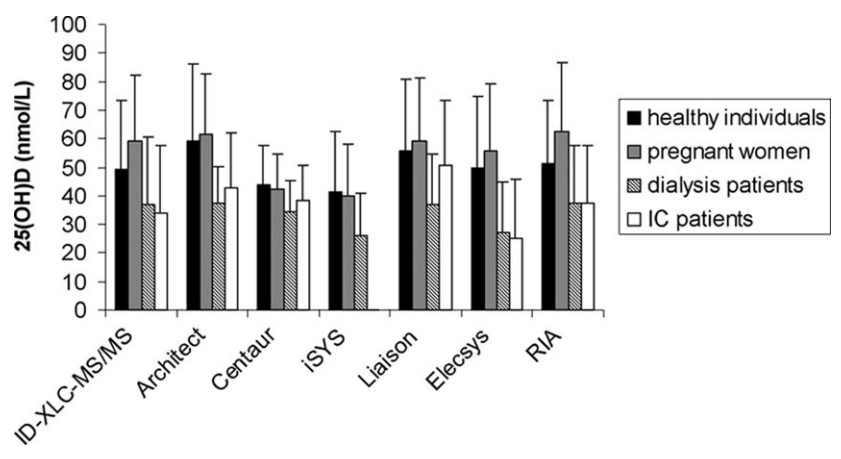Different measurements from 6 vitamin D testing systems
Accuracy of 6 Routine 25-Hydroxyvitamin D Assays: Influence of Vitamin D Binding Protein Concentration
Clinical Chemistry March 2012 vol. 58 no. 3 543-548
Annemieke C. Heijboer1, a.heijboer@vumc.nl
Marinus A. Blankenstein1,
Ido P. Kema2 and
Madelon M. Buijs3
1 Department of Clinical Chemistry, VU University Medical Center, Amsterdam, the Netherlands;
2 Department of Laboratory Medicine, University Medical Center, Groningen, the Netherlands;
3 Medial Diagnostic Centers, Hoofddorp, the Netherlands.
BACKGROUND: Recent recognition of its broad pathophysiological importance has triggered an increased interest in 25-hydroxyvitamin D [25(OH)D]. By consequence, throughput in 25(OH)D testing has become an issue for clinical laboratories, and several automated assays for measurement of 25(OH)D are now available. The aim of this study was to test the accuracy and robustness of these assays by comparing their results to those of an isotope dilution/online solid-phase extraction liquid chromatography/tandem mass spectrometry (ID-XLC-MS/MS) method. We put specific focus on the influence of vitamin D–binding protein (DBP) by using samples with various concentrations of DBP.
METHODS: We used 5 automated assays (Architect, Centaur, iSYS, Liaison, and Elecsys), 1 RIA (Diasorin) preceded by extraction, and an ID-XLC-MS/MS method to measure 25(OH)D concentrations in plasma samples of 51 healthy individuals, 52 pregnant women, 50 hemodialysis patients, and 50 intensive care patients. Using ELISA, we also measured DBP concentrations in these samples.
RESULTS: Most of the examined 25(OH)D assays showed significant deviations in 25(OH)D concentrations from those of the ID-XLC-MS/MS method.
As expected, DBP concentrations were higher in samples of pregnant women and lower in samples of IC patients compared to healthy controls.
In 4 of the 5 fully automated 25(OH)D assays, we observed an inverse relationship between DBP concentrations and deviations from the ID-XLC-MS/MS results.
CONCLUSIONS: 25(OH)D measurements performed with most immunoassays suffer from inaccuracies that are DBP concentration dependent. Therefore, when interpreting results of 25(OH)D measurements, careful consideration of the measurement method is necessary.
Received for publication September 27, 2011; Accepted for publication December 2, 2011.
PDF of article and editorial are attached at bottom of this page
Each same-shaded bar is the result of testing of 50 women
Notice the difference between same-shaded bars by different testing systems
Largest differences between systems are for pregnant women (who have the largest differences in vitamin D–binding protein)

